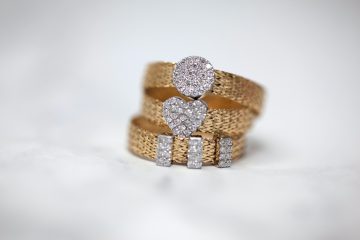Diamonds are a lady’s best friend. This is a quote that you have probably heard more than once.
Diamonds are the most sought-after and attractive gemstone and decoration for jewelry. There is just something special about diamonds that not any other stone can compare with. The name “Diamond” comes from the Greek Adamas and means invincible. This name probably relates to the name of the diamond’s hardness. The diamond is the hardest substance found in nature. Hardness is usually measured using Moh’s hardness scale. You can test yourself at home by scratching two different minerals against each other. Whichever gives the scratch is the hardest. The hardness scale goes from 1 to 10. The diamond is a ten!
In this post, we will teach you more about diamonds, what to think about when buying them or diamond jewelry, and also how to choose a diamond ring that suits you.
Quality of diamonds – the 4 Cs
- The quality of a diamond is assessed using the four Cs:
- Clarity: The cleaner from inclusions a diamond is, the more beautiful the light is refracted. In order to measure the purity of a diamond, the diamond is inspected, for example with a loupe and then graded according to a scale.
- Color: The diamond is graded by color tone where the most colorless has the highest quality. Calling it color is really a bit misleading since what you are actually looking for when examining a diamond is actually the lack of color. The color is usually graded on a scale from D to Z.
- Cut: The diamond is cut to reflect the light and give a sparkling appearance.
- Carat: Unit indicating the weight of the diamond. “Carat” regarding a diamond must not be mixed with the purity measure “carat” for gold. Carat is the weight of the diamond. One carat is 0.2 grams.
These are the colors of diamonds:
- River (D-E) Blue-white
- Top Wesselton (F-G) Fine white
- Wesselton (H) Vit
- Top Crystal (I) Slightly toned white
- Crystal (J) Tinted white
- Top Cape (K-L) Slightly yellowish
- Cape (M-N) Yellowish
- Light Yellow (O-R) Slightly yellow
- Yellow (S-Z) Yellow
Common diamond cuts
There are many different cuts you can use for diamonds.
Brilliant: Brilliant grinding gives the diamond its round shape with its 58 facets. The grinding gives an optimal reflection of the light and is the most popular. It was not until the 1940s that the jewel took its present form with 58 facets and characteristic shape with a round top and pointed underside. Brilliant grinding is today one of the most common grindings of diamonds and other gemstones. In fact, many of the most popular diamond cuts today are relatively new and have been developed during the latter part of the 20th century.
Another cut is that the diamond is ground to square shape with pointed corners and is our second most common grinding.
Princess cut
Princess cut diamonds are one of the most common variants after the brilliant and very popular, not least in engagement and wedding rings. A princess-cut diamond is square or rectangular in shape with characteristic pointed corners. Princess cut diamonds reflect slightly less light (they do not sparkle as much) than brilliant cut diamonds but are nevertheless designed to reflect as much light as possible.
Baguette cuts
Baguette-cut diamonds are just as the name implies elongated. Most often, baguette cut is used for smaller diamonds, which should be complementary side stones to a larger diamond in jewelry. A baguette-cut diamond generally has quite a few facets and is therefore usually cheaper than, for example, brilliants.
Buying a diamond ring
It is important that the ring you are going to wear through life is perfectly seated, so try it several times. Choose an engagement ring or wedding ring to symbolize the love of your partner, give away a beautiful ring to celebrate an anniversary or a happy birthday, or treat yourself to a fantastic piece of jewelry to wear throughout your life.
To many, the diamond ring is the ultimate gift to get or to treat yourself. The ring is one of the jewelry that for many people also has a symbolic value. You can choose a ring in white gold or yellow gold and with small or large diamonds according to taste and taste. If you want something more unusual, there are also diamond rings in rose gold.
Diamond rings are available in all price ranges from the more savory with small diamonds to the more extravagant with one or more large diamonds. In addition to just diamonds, there are also rings with a combination of diamonds and other precious stones such as ruby, sapphire, emerald, amethyst, or why not choose a ring with diamond and blue topaz? Maybe you choose our big favorite, the ring in 18K white or yellow gold that has both diamond, amethyst, citrine, topaz, peridot, and rhodolite!
Diamond Grading Report
When buying jewelry with larger diamonds (0.5 carats or larger), a diamond grading report usually comes with many sellers. That report states what the grinding quality of the diamond is if the rating agency grinds the current type of diamond. The price should be higher for a better quality of grinding. However, grinding is the factor that affects the price the least of the 4 Cs (Carat, Color, Clarity and Cut).
Treated diamonds
Another thing to keep in mind when buying diamond jewelry is that some vendors sell processed diamonds (enhanced). These diamonds actually have a worse color and/or more inclusions than the stone naturally has.
To increase the clarity of a diamond, you can drill with laser small holes in the diamond to remove ugly inclusions, e.g. a black dot. Then you fill the holes with glass or some other substance. This makes the diamond less durable for example blows. In addition, it lowers the price sharply. This treatment is called clarity enhancement.
In order to get a uniform color in the diamond, for example, you can irradiate the diamond, so-called. irradiation (also called color enhancement). Then you get a smoother and stronger color.
Naturally colored stones, e.g. blue, pink, green, etc. are unusual and therefore expensive.



